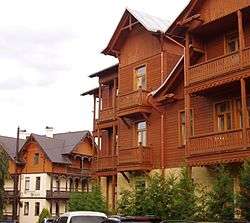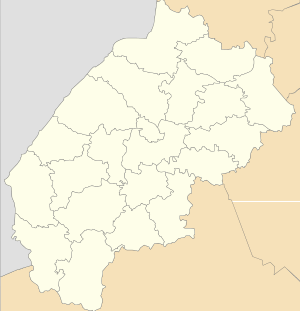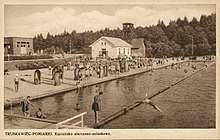Truskavets
Truskavets (Ukrainian: Трускавець, translit. Truskavets'; Polish: Truskawiec; Yiddish: טרוסקעוויץ Truskevitz) is a city in western Ukraine's Lviv Oblast (region), near the border with Poland. It is designated as a city of oblast significance. Its population is approximately 28,867 (2017 est.)[1].
Truskavets Трускавець Truskawiec | |
|---|---|
 Villa Under the Mother of God and Villa Zosia | |
 Flag  Coat of arms | |
 Truskavets  Truskavets | |
| Coordinates: 49°16′50″N 23°30′18″E | |
| Country | |
| Oblast | |
| Municipality | Truskavets |
| Area | |
| • Total | 8 km2 (3 sq mi) |
| Population (2013) | |
| • Total | 29,516 |
| • Density | 3,737/km2 (9,680/sq mi) |
| Time zone | UTC+2 (EET) |
| • Summer (DST) | UTC+3 (EEST) |
| Postal code | 82200 |
| Area code(s) | +380-3247 |
| Website | https://truskavets.ua/en/ |
Truskavets is famous for its mineral springs, which have made it one of Ukraine's great resorts. For most visitors the primary goal is consuming the various 'local waters.' The most famous is the sulfur-scented, slightly saline 'Naftusia.' The town lies in an attractive little valley in the Carpathian foothills and is easily reached from Lviv by bus or train. The vast majority of tourists who come to Truskavets are either Ukrainian or Russian.
In 2000, a special economic zone (SEZ) was established in Truskavets for the period of 20 years.[2] Known as "Kurortopolis Truskavets", the SEZ offers various tax privileges for businesses and investors. Some 13 investment projects have been approved under its framework, with the majority focusing on health and medical treatment.[3]
History

Truskavets, then as Truskawiec, was first mentioned in 1469. The Polish royal doctor Wojciech Oczko was the first to describe local waters in 1578.[4] At that time the village was property of Kings of Poland, and was located in the Ruthenian Voivodeship in the Lesser Poland Province of the Polish Crown until the First Partition of Poland in 1772, when it fell to Austria. First baths were opened here in 1827. In 1836, Józef Micewski, with support of Agenor Goluchowski, initiated construction of the spa complex. In 1853, the village was visited by Archduke Karl Ludwig of Austria. In the mid-19th century, a Catholic church was built, financed by visitors' contributions.[4] Thanks to the liberalization of Austrian policy towards minorities, including Poles, in 1880 the spa became the property of a company whose chairman was Adam Stanisław Sapieha, and then it was expanded.[5][6] In 1898, a monument to Polish national poet Adam Mickiewicz, in the 100th anniversary of his birth, was unveiled in the spa park.[4] In 1911, a rail station was opened here, and by 1913, the town was receiving around 5,000 visitors per year. The spa was not destroyed during World War I, however, the number of visitors dropped significantly.[7]
.jpg)
Following the collapse of the Austro-Hungarian Empire, the Polish–Ukrainian War and the Polish–Soviet War, Truskawiec became part of Poland again.[7] Administratively it was the seat of Gmina Truskawiec, located in the Drohobycz County of the Lwów Voivodeship. As the spa was not destroyed in these conflicts, activity resumed quickly, as early as 1920[7] and Truskawiec soon emerged as a popular spa destination. In the 1920s and 1930s, almost 300 hotels, villas and guest houses were built here. The town was awarded three gold medals as the country's best spa resort.[4] Next to Krynica-Zdrój, it was the most visited and most popular resort in Poland.[8] A number of notable Polish personalities visited Truskawiec during that era, including politicians (Stanisław Wojciechowski, Józef Piłsudski, Wincenty Witos, Ignacy Daszyński), artists (Eugeniusz Bodo, Adolf Dymsza, Julian Tuwim, Stanisław Ignacy Witkiewicz, Bruno Schulz, Zofia Nałkowska, Marian Hemar, Hanka Ordonówna, Jan Kiepura, Zofia Batycka, Antoni Słonimski), athletes (Stanisława Walasiewicz, Halina Konopacka, Janusz Kusociński) and Generals Stanisław Maczek and Kazimierz Sosnkowski.[8] Numerous guests from abroad came there as well.[8] In 1935, the Prime Minister and future president of Estonia Konstantin Päts visited the spa.[8] Rajmund Jarosz, who was the owner of the spa since 1911, founded the Museum of Natural History (Muzeum Przyrodnicze) and a salt-sulfur pool, later destroyed during World War II.[8]

On August 29, 1931, Vasyl Bilas and Dmytro Danylyshyn, two members of the Organization of Ukrainian Nationalists, assassinated Tadeusz Hołówko, a Polish cabinet minister and known advocate of Polish-Ukrainian rapprochement vacationing in Truskawiec.[8] This caused an increase in Polish-Ukrainian tension, which culminated in the Ukrainian genocide of Poles in 1943.[8]
After the Soviet invasion of Poland in 1939, the spa was transformed into a sanatorium for Red Army soldiers.[6] From 1941 to 1944 it was under German occupation, and after 1944 under Soviet occupation again.[6] Under the Potsdam Agreement of 1945, it was taken from Poland and annexed by the Soviet Union. Under Soviet rule, most of the historic buildings were destroyed and replaced with typical Soviet architecture.[8]
In 2008, the Adam Mickiewicz monument, which survived World War II and Soviet rule, was renovated.[8]
Twin towns
Truskavets is twinned with:
Gallery
- Truskavets. Trading House.
- Old Town Hall
 Spa Rehabilitation Center Truskavets resort
Spa Rehabilitation Center Truskavets resort Downtown Truskavets
Downtown Truskavets City hall
City hall Residential building
Residential building St. Nicholas Church
St. Nicholas Church Villa Anastasia
Villa Anastasia- Villa Goplana, housing the City Museum
- Adam Mickiewicz statue in Truskavets city park
- Church of the Assumption and John Paul II statue
- Monument to Vasyl Bilas and Dmytro Danylyshyn
References
- "Чисельність наявного населення України (Actual population of Ukraine)" (in Ukrainian). State Statistics Service of Ukraine. Retrieved 26 August 2017.
- Business Cooperation with Ukraine | Regions Potential | Lviv Region . Retrieved on 2008-12-26.
- Truskavets Official Website | "About the City"

- Cezary Rudziński. "Truskawiec. Dzieje uzdrowiska u podnóża Gorganów". Otwarty Przewodnik Krajoznawczy (in Polish). Retrieved 13 October 2019.
- Ireneusz Jasiuk, Truskawiec - dzieje kresowego uzdrowiska na tle różnorodności kulturowej i etnicznej Małopolski Wschodniej, published in "Acta Humana” no. 8, 2017, p. 233-234 (in Polish)
- "Truskawiec - Historia miejscowości". Wirtualny Sztetl (in Polish). Retrieved 13 October 2019.
- Jasiuk, Op. cit., p. 234
- "Truskawiec - kurort marzeń". Nowa Trybuna Opolska (in Polish). Retrieved 13 October 2019.
- "Jasło Official Website – "Współpraca Międzynarodowa Jasła" (Jasło's Twin Towns)".

Sources
- Brian R. Banks (2006). Muse & Messiah: The Life, Imagination & Legacy of Bruno Schulz (1892–1942). Inkermen Press UK. ISBN 0-9551829-6-4. An account of the town and neighborhood including Drohobycz along with its relationship to this author and his friends like other Polish writers such as Zofia Nałkowska and Witkacy.
External links
![]()